Speckled pigeons AKA, the African Rock Pigeon, are unique-looking pigeons that are endemic to sub-Saharan Africa.
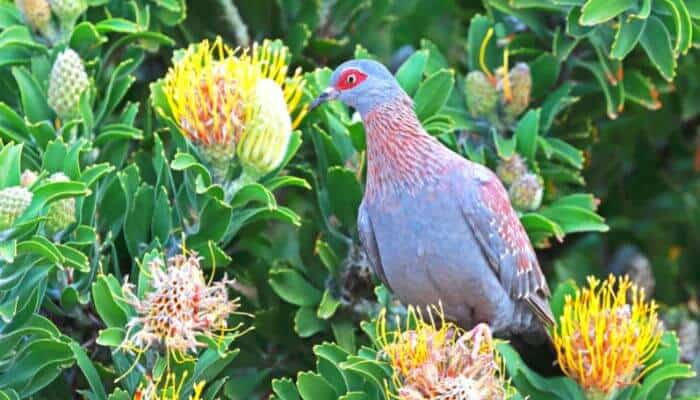
Origins of the Speckled Pigeon
The speckled pigeon is also known as the African rock pigeon.
It’s originally from Africa, particularly in the regions south of the Sahara Desert.
The pigeons were transported from Guinea’s interior in West Africa.
Distribution & Habitat of the Speckled Pigeon
They can commonly be found in open grasslands, scrubland and urban areas.
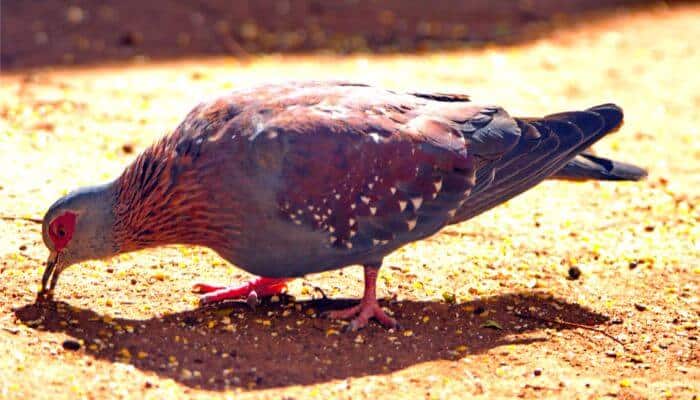
Their habitat also includes deserts, rocky cliffs, and savanna grasslands.
Closest Columbidae Relatives of the Speckled Pigeon
Doves and pigeons belong to a vast, well-known family found all over the world.
The order Columbiformes is composed of pigeons, or Columbidae. It also includes the Raphidae family of the extinct dodo bird.
The Columbiformes species are similar to the speckled pigeons. For instance, the same white patches and dark maroon uppers are seen on African olive pigeons.
Although, these birds have yellow legs, bills, and orbital skin.
The plumage on the Feral pigeon also resembles that of the Speckled pigeons. However, they frequently lack the red orbital skin.
Although they bear little similarity to our pigeons, the Samoan tooth-billed Pigeon, aka Didunculus strigirostris has a bill that, despite being much smaller, is strikingly similar to that of the Dodo.
Speckled Pigeon Appearance
The speckled pigeon’s unique features include a red exposed patch around the eyes. A white streak divides this exposed area from the rest of the gray plumage.
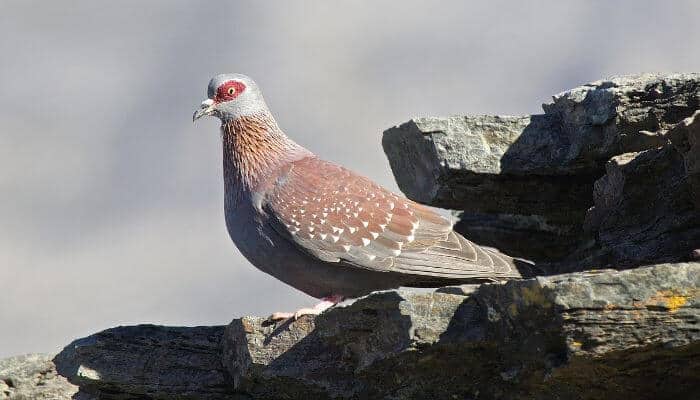
They have a throat with silvery pink-green feather tips, and dark red outermost wing feathers. Pearl gray covers the rest of their feathers. They have dark gray tails with thick black tips.
However, newborn chicks are covered only with a thin layer of gray plumage.
Female and male speckled pigeons can’t be told apart solely based on appearance.
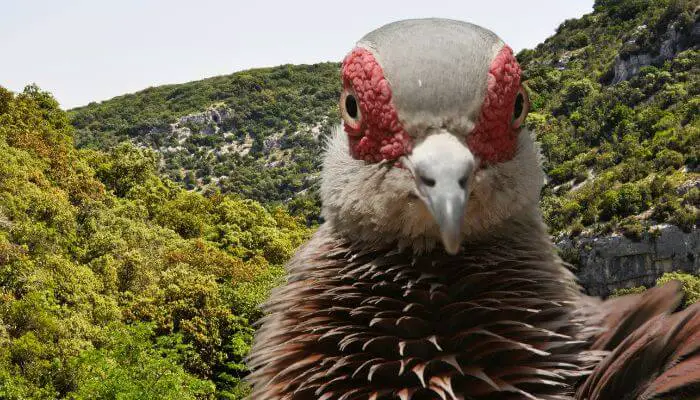
Males are often slightly larger than females. Therefore, with some training, you might be able to differentiate between them.
| Wingspan | Length | Weight | Coloring | |
|---|---|---|---|---|
| Speckled Pigeon | 64 – 78 cm | 32 – 41 cm | 219 – 397 g | Gray, brown, and white with pink and red tones |
| Average Feral Pigeon | 64 – 72 cm | 32 – 37 cm | 300 – 500 g | Bluish gray with some black |
Facts About the Speckled Pigeon
There are also some fun facts about the speckled pigeons that are worth mentioning.
- The term “cock” refers to a male pigeon, while “hens” are female pigeons, and “squabs” refers to young pigeons.
- The IUCN lists the speckled pigeon as Least Concern due to the absence of any known threats. Plus, it’s both familiar and expanding in population across its range.
- Pigeons in the Columbidae family may reach speeds of up to 93 miles per hour.
- The only birds known to make crop milk specifically for their young are pigeons, doves, and flamingos.
- When drinking, speckled pigeons keep their heads down and use their beaks as a straw to sip water. This is in contrast to most other birds that take a sip, then throw their heads back to swallow.
Speckled Pigeon Character
Take a look at some of the unique features of this species.
- The speckled pigeons use their voices to communicate. They make cooing noises that change in tempo to convey different messages to their flock.
- They form big, loud flocks, especially when feeding. However, they’re typically observed walking or sprinting in pairs.
- They’re drawn to urban structures like telephone poles, billboards, and abandoned buildings.
- It’s known that these pigeon species live in flocks of almost hundreds of birds. These birds are reported to be primarily seen in pairs during the breeding season.
The Diet of the Speckled Pigeon
The majority of food consumed by these birds is in the form of seeds, both from wild and domesticated grasses. Maize, wheat, and sorghum are their favorite meals.
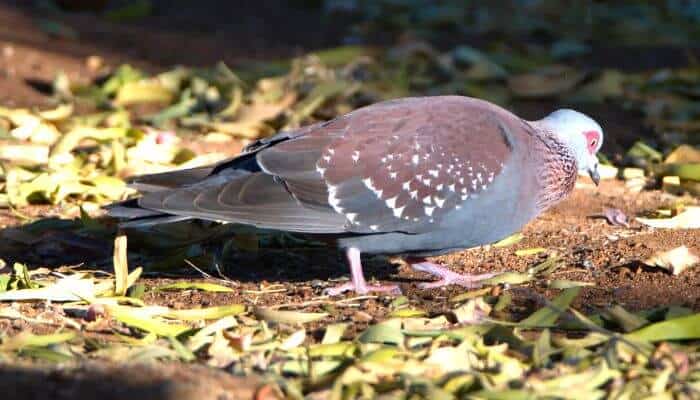
Interestingly, pigeons are also known to eat land mollusks. The most common example is garden snails and slugs.
Mating and Breeding of the Speckled Pigeon
To seduce the female, the male pigeon puts in a lot of effort. They do this by either flaunting their feathers, bowing, crouching, or soaring.
Pigeons don’t have a specific breeding season; they mate year-round.
One reason is that both the males and females can produce bird milk inside their crop, which they feed their squabs. So, the little birds are equally cared for by both parents.
They nest in what is considered a pretty modest shelter made out of a few twigs. The male and female take turns building the nest where they prefer setting it up in an open and abandoned crevice, like under eaves, rain gutters, or rafters.
They use the nest primarily as a roosting site, where, typically, a clutch of speckled pigeons will lay two eggs. The incubation period varies depending on the location.
Next, the squabs are born after a 14–18 day incubation period. After hatching, the chicks will remain in the nest for about 20 to 25 days before venturing out on their own to look for food.
During this time, they began growing thicker plumage. Then, after about six months, a juvenile pigeon will be ready to breed.
Caring for Speckled Pigeons
If you’re thinking of getting a Speckled pigeon, here are a few tips to get you started:
- Speckled pigeons are intelligent birds that can be trained and enjoy being petted. They can also coexist peacefully with other creatures, which is why they make excellent pets.
- Make sure you provide your speckled pigeon with their needed food of seeds and crops.
- Since speckled pigeons are a social breed, try not to keep only one. Instead, keep a pair to enhance their mood and help them live longer.
Conclusion
Speckled pigeons are truly a special breed of birds. They have a unique appearance and amazing features that make them enjoyable to watch from a distance or even keep as pets!
They’re social creatures that enjoy being part of a big flock. Still, they’re pretty low-maintenance compared with other species.
So, if you decide to own pigeons, make sure you get two, so they can keep each other company. More importantly, don’t forget to pet them and show them lots of love and attention, and they’ll be your new besties!
